| Islands / I Lands, NOW—Vista de Cuba |
|---|
|
|
Nicolás Guillén Landrián
| Nicolás Guillén Landrián
Born in 1938 in Camagüey. Studied social science and politics at the University of Havana and dropped out to work as a radio-station announcer. In 1962, he started to work as an assistant producer and director at ICAIC. He learned from Joris Ivens who had been invited by ICAIC to give courses and lectures and participated in Ivens’s Travel Notebook (1961) as a narrator. Starting in 1963, such films by Guillén Landrián as In an Old Neighborhood appeared. In 1965, Guillén Landrián directed Ociel of the Toa River, which, together with Reportage (1966) and Return to Baracoa (1966), forms a trilogy filmed in eastern Cuba. These works established Guillén Landrián’s original style of ethnographic or experimental documentary in Cuban cinema, which was influenced by Italian Neorealism and the Nouvelle Vague. His cinema discourse on revolutionary process and film aesthetics remains an inspiration to young filmmakers. In 1989, he emigrated to the United States, where he made Inside Downtown in 2001. On July 23, 2003, he died in Miami, a victim of pancreatic cancer. National poet Nicolás Guillén is his paternal uncle. |
For all the following films by Guillén Landrián, production company and source: ICAIC
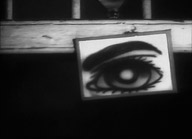 In an Old Neighborhood
In an Old Neighborhood
En un barrio viejo- CUBA / 1963 / No dialogue / B&W / Video (Original: 35mm) / 9 min
Director, Script: Nicolás Guillén Landrián
Photography: Livio Delgado
Editing: Caíta Villalón
Sound: Ricardo Istueta
Producer: Roberto León Henríquez
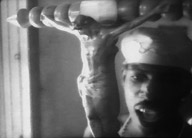 Featuring images of old Havana, with its dilapidated houses, its tiled roofs, its small towers, its narrow sidewalks, its cobblestone streets, its people . . . An affectionate experimental short documentary that paints a mosaic of Cuba by focusing on a microcosmic “old neighborhood,” where the country’s personality slowly emerges through its various dualities: young and old, sound and silence, Christianity and Santería, civilian life and military presence, poverty and abundance, etc. A renowned work by Guillén Landrián.
Featuring images of old Havana, with its dilapidated houses, its tiled roofs, its small towers, its narrow sidewalks, its cobblestone streets, its people . . . An affectionate experimental short documentary that paints a mosaic of Cuba by focusing on a microcosmic “old neighborhood,” where the country’s personality slowly emerges through its various dualities: young and old, sound and silence, Christianity and Santería, civilian life and military presence, poverty and abundance, etc. A renowned work by Guillén Landrián.
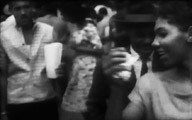 Dancers
Dancers
Los del baile- CUBA / 1965 / Spanish / B&W / Video (Original: 35mm) / 6 min
Director, Script: Nicolás Guillén Landrián
Photography: Luis García
Editing: María Esther Valdés, Justo Vega
Music: Pello el Afrokán, Federico García
Producer: Eduardo Valdés Rivero
People dancing to the Latin music rhythm of “Mozambique,” invented by Pello el Afrokán, for which Cuban music once again became known throughout the world. Contrasting the frenetic trance of the sexes under the sway of the music, there are faces rapt in private thoughts, accompanied by the soft sounds of the clavichord. And again people dance, a Cuban fiesta of rhythm.
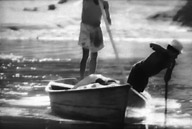 Ociel of the Toa River
Ociel of the Toa River
Ociel del Toa- CUBA / 1965 / Spanish / B&W / Video (Original: 35mm) / 17 min
Director, Script: Nicolás Guillén Landrián
Photography: Livio Delgado
Editing: Caíta Villalón
Music: Roberto Valera
Producer: José Gutiérrez
A black-and-white poem structured around the daily life of the country boy Ociel, who lives on the Toa River in the Oriente province of Cuba. He spends most of his time rowing a log boat in the river. On weekends he enjoys the modest diversion of going to dances and cockfights and attending school and church in the nearest village.
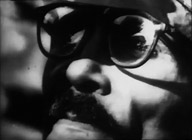 Return to Baracoa
Return to Baracoa
Retornar a Baracoa- CUBA / 1966 / Spanish / B&W / Video (Original: 35mm) / 15 min
Director, Script: Nicolás Guillén Landrián
Photography: Livio Delgado
Editing: Amparo Laucerica
Music: Leo Brouwer, Ulises Fernández
Producer: José Gutiérrez
Located in the eastern tip of the island, and famous for its chocolate production, Baracoa sees new factories and development causing changes in economy and social systems after the Revolution . . . This short is the first of many in which Guillén Landrián experiments with still photographs, photo-animation, and text inserts.
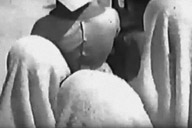 Reportage
Reportage
Reportaje (Plenaria campesina)- CUBA / 1966 / Spanish / B&W / Video (Original: 35mm) / 9 min
Director, Script: Nicolás Guillén Landrián
Photography: Livio Delgado
Editing: Justo Vega
Music: Armando Guerra
Producer: José Gutiérrez
A funeral procession in which villagers march along a mountain path to solemn music bearing the coffin of “Don Ignorancia.” In spite of the sobbing and the kerchiefs covering people’s noses, on closer look the procession reveals itself to be only a symbolic one, with a cardboard box for a coffin . . . “Ignorancia” means ignorance in Spanish. Compared to the previous works of the filmmaker, the last of the trilogy is submerged in a more grave and somber tone.
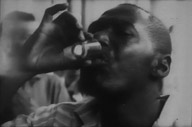 Coffea Arabica
Coffea Arabica
Coffea Arábiga- CUBA / 1968 / Spanish / B&W / Video (Original: 35mm) / 18 min
Director: Nicolás Guillén Landrián
Photography: Lupercio López
Editing: Iván Arocha
Sound: Rodolfo Praza
Producer: Jorge Rouco
From planting seeds and fumigation to harvesting and roasting, this account of coffee growing then proceeds, in a radically experimental way, to fade in the noise of omnipresent propaganda. Guillén Landrián’s short documentary violates the conventions of cinematic language through its use of montage, photo-animation, and inserts of texts. The filmmaker also cites a poem by his uncle, Nicolás Guillén.
